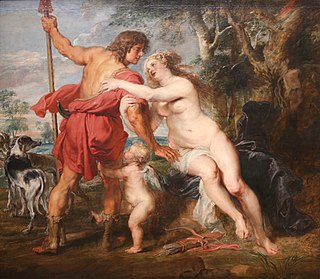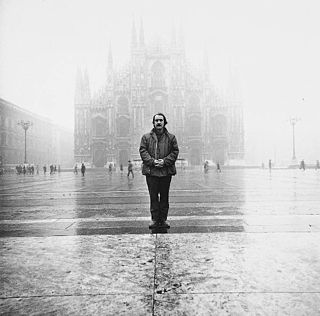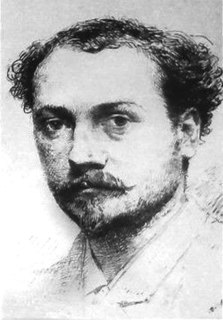
The Baroque is a style of architecture, music, dance, painting, sculpture and other arts that flourished in Europe from the early 17th century until the 1740s. In the territories of the Spanish and Portuguese empires including the Iberian Peninsula it continued, together with new styles, until the first decade of the 1800s. It followed Renaissance art and Mannerism and preceded the Rococo and Neoclassical styles. It was encouraged by the Catholic Church as a means to counter the simplicity and austerity of Protestant architecture, art and music, though Lutheran Baroque art developed in parts of Europe as well.

Jean-Antoine Houdon was a French neoclassical sculptor.

The Prix de Rome or Grand Prix de Rome was a French scholarship for arts students, initially for painters and sculptors, that was established in 1663 during the reign of Louis XIV of France. Winners were awarded a bursary that allowed them to stay in Rome for three to five years at the expense of the state. The prize was extended to architecture in 1720, music in 1803, and engraving in 1804. The prestigious award was abolished in 1968 by André Malraux, the Minister of Culture, following the May 68 riots.

Jean-Baptiste Claude Eugène Guillaume was a French sculptor.
Jean de la Vallée was a Swedish architect.

Edmé Bouchardon was a French sculptor best known for his neoclassical statues in the gardens of the Palace of Versailles, his medals, his equestrian statue of Louis XV of France for the Place de la Concorde (destroyed during the French Revolution; and for the Fountain of Four Seasons in Paris. He was also a draftsman and painter, and made celebrated series of engravings of working-class Parisians.

Pierre-Jean David was a French sculptor, medalist and active freemason. He adopted the name David d'Angers, following his entry into the studio of the painter Jacques-Louis David in 1809 as a way of both expressing his patrimony and distinguishing himself from the master painter.
Events from the year 1610 in art.

Jean Tinguely was a Swiss sculptor best known for his kinetic art sculptural machines that extended the Dada tradition into the later part of the 20th century. Tinguely's art satirized automation and the technological overproduction of material goods.

Pierre Le Gros the Elder was a French sculptor in the service of King Louis XIV.

François de Troy was a French painter and engraver who became principal painter to King James II in exile at Saint-Germain-en-Laye and Director of the Académie Royale de peinture et de sculpture.

Baroque sculpture is the sculpture associated with the Baroque style of the period between the early 17th and mid 18th centuries. In Baroque sculpture, groups of figures assumed new importance, and there was a dynamic movement and energy of human forms—they spiralled around an empty central vortex, or reached outwards into the surrounding space. Baroque sculpture often had multiple ideal viewing angles, and reflected a general continuation of the Renaissance move away from the relief to sculpture created in the round, and designed to be placed in the middle of a large space—elaborate fountains such as Bernini's Fontana dei Quattro Fiumi, or those in the Gardens of Versailles were a Baroque speciality. The Baroque style was perfectly suited to sculpture, with Gian Lorenzo Bernini the dominating figure of the age in works such as The Ecstasy of St Theresa (1647–1652). Much Baroque sculpture added extra-sculptural elements, for example, concealed lighting, or water fountains, or fused sculpture and architecture to create a transformative experience for the viewer. Artists saw themselves as in the classical tradition, but admired Hellenistic and later Roman sculpture, rather than that of the more "Classical" periods as they are seen today.
A Christian Hebraist is a scholar of Hebrew who comes from a Christian family background/belief, or is a Jewish adherent of Christianity. The main area of study is that commonly known as the Old Testament to Christians, but Christians have occasionally taken an interest in the Talmud, and Kabbalah.

René-Antoine Houasse was a decorative French painter.

Charles Errard the Younger was a French painter, architect and engraver, co-founder and later director of the Académie Royale de Peinture et de Sculpture. In 1666 Louis XIV's minister Jean-Baptiste Colbert sent him to found the Académie de France à Rome, where he was director until 1684.
Francesco Maria Nocchieri, born in Ancona, was a seventeenth-century Italian sculptor of minor reputation active in Rome, where he spent time in the large studio of Bernini. He worked largely as a restorer of antiquities. He was among the many Roman sculptors patronised by Christina, Queen of Sweden in her retirement in Rome; for Christina he executed an Apollo (1680) to complement a set of Roman sculptures of Muses that had been found at Hadrian's Villa, which were doubtless restored by Nocchieri; the Apollo is now at La Granja de San Ildefonso. The largest collection of Nocchieri's sculptures today are in the Gardens of Aranjuez, Madrid. A terracotta bozzetto at the Ashmolean Museum represents Apollo holding his lyre, attentive to the Muses.

Émile Edmond Jean Peynot was a prominent French artist and sculptor.

Angelo de Rossi was an Italian sculptor. Born in Genoa, he was apprenticed to Filippo Parodi in 1680; Parodi's influence is clear in his first pre-1689 work, a Small Satyr in marble. Nearly unavoidably, he was also influenced by the work of Pierre Puget. He went to Rome in 1688, remaining there until his death; a 1692 relief of Three Men in the Fiery Furnace won first prize in all three sculpture classes at the Accademia di San Luca.

Francis van Bossuit was a Flemish sculptor. He mainly carved sculptures in ivory. Only a few sculptures in wood and terracotta by his hand are known. His work shows a penchant for classicism which was probably derived from his exposure to ancient and contemporary Italian art during his stay in Rome as well as his knowledge of the Baroque classicism of the sculptors active in Versailles. The exuberance of some of his works also reflects his training in Flemish Baroque sculpture.

The Style Louis XIV or Louis Quatorze, also called French classicism, was the style of architecture and decorative arts intended to glorify King Louis XIV and his reign. It featured majesty, harmony and regularity. It became the official style during the reign of Louis XIV (1643–1715), imposed upon artists by the newly established Académie royale de peinture et de sculpture and the Académie royale d'architecture. It had an important influence upon the architecture of other European monarchs, from Frederick the Great of Prussia to Peter the Great of Russia. Major architects of the period included François Mansart, Jules Hardouin Mansart, Robert de Cotte, Pierre Le Muet, Claude Perrault, and Louis Le Vau. Major monuments included the Palace of Versailles, the Grand Trianon at Versailles, and the Church of Les Invalides (1675–91).
















